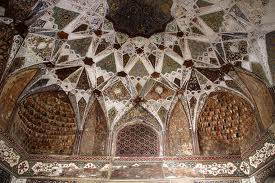Itmad-Ud-Daulah
Book Now
Itmad-Ud-Daulah In Agra
 Itmad-ud-Daulah, also known as the ‘Baby Taj’, is the first monument in India built entirely in marble. The tomb was built between 1622 and 1628 by the Queen of Jahangir, Nurjahan as a memorial to her father, Mirza Ghiyas Beg. Mirza Ghiyas Beg, an Imperial Officer, was bestowed with the title of Itmad-ud-Daulah (Pillar of State) by his Emperor Jahangir. The mausoleum rests in a walled garden close to the Yamuna River, approximately one and a half kilometers upstream of the Taj Mahal, Agra. This tranquil, small, garden was to inspire the construction of the Taj Mahal in the later years. Itmad-ud-Daulah, also known as the ‘Baby Taj’, is the first monument in India built entirely in marble. The tomb was built between 1622 and 1628 by the Queen of Jahangir, Nurjahan as a memorial to her father, Mirza Ghiyas Beg. Mirza Ghiyas Beg, an Imperial Officer, was bestowed with the title of Itmad-ud-Daulah (Pillar of State) by his Emperor Jahangir. The mausoleum rests in a walled garden close to the Yamuna River, approximately one and a half kilometers upstream of the Taj Mahal, Agra. This tranquil, small, garden was to inspire the construction of the Taj Mahal in the later years.
History of Itmad-Ud-Daulah
The tomb was built in the famed Char Bagh style that Itmad-ud-Daulah had himself laid out six years before his death 1622. The whole structure gives the impression of an enlarged precious object with a height of 21 m and a dome-roofed octagonal minaret of 12 m each at each corner. The structure is renowned for its pietra dura decoration i.e. the inlay works and carvings depicting cypresses, wine glasses and an amazing variety of geometrical arabesque. Due to the profusion of intricate work done on marble and the beautiful marble screen-work, the tomb easily qualifies as a veritable forerunner of the famous Taj Mahal.
 Architecture of Itmad-Ud-Daulah Architecture of Itmad-Ud-Daulah
The pure white and elaborately carved tomb of Itmad-ud-Daulah conforms to the Islamic style of architecture. The use of arched entrances, octagonal shaped towers or minarets, use of exquisitely carved floral patterns, intricate marble-screen work and inlay work are all representative of the Islamic style. The absence of a dome and the presence of a closed kiosk on top of this building and the use of chhatris (small domed canopies, supported by pillars) atop the four towers (minarets) instead of proper domes are reflective of local influence. Along with the main building, the structure consists of numerous outbuildings and gardens. It houses the cenotaph of Mirza Ghiyas Beg and Nurjahan’s mother Asmat Begum that resembles a jewel box and is set in a garden side by side. The adjacent chamber has the tombs of the other members of the family.
Best time to visit
The tomb can be visited anytime of the year. Though, the best time to visit Agra is between November to Febuary when the weather is cool and conducive.
How to Reach
By Air: Agra airport is 7 km from the city center and 3 km from Eidgah bus stand. Major airlines operate daily tourist shuttle flights to Delhi, Mumbai, Kolkata and Banglore.
By Rail: The main railway station is the Agra Cantonment station that is well connected to Delhi, Varanasi and other cities of Utter Pradesh Rajasthan. Trains like Palace on Wheel, Shatabdi, Rajdhani, and Taj Express are the best choices if you want to reach Agra from Delhi.
By Road: Many National Highways connect Agra to all major Indian cities. Express and A/C bus services are available from Delhi, Jaipur, Lucknow, Gualior and Jhansi. 'Idgah' is the main bus terminal in Agra.
|